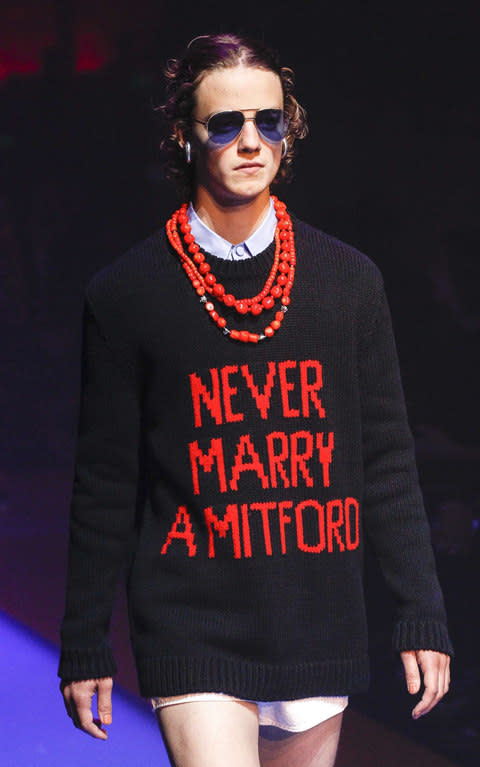How would the Mitford sisters have lived in the modern world?

The Mitfords were the original tribe of It-girls: lovely young things who somehow encapsulated all the different facets of their age while not showing the least bit of concern about what anyone else might think. Their notoriety was so pervasive, in fact, that a jumper bearing the slogan 'Never Marry a Mitford' graced the Gucci catwalk at Milan Fashion Week, inspired by one of the Duke of Devonshire's own designs.
They married Nazis, communists and aristocrats, were slung into jail, travelled the world, became writers, and, through Nancy – the cleverest of them all – invented an entire social code.
So influential was her idea of “U” (upper) or “non-U” behaviour and vocabulary that it still persists 70 years after she first came up with it (even though it was pretty tongue-in-cheek at the time).
Interesting then to imagine how the Mitfords might view the modern culture which all the denizens of reality TV like the Kardashian family have created. What would the sisters have made of mobile phones at the dinner table or girls slapping on make-up as they take the tube to work? Ready meals or Ryanair?
Perhaps I’m better placed than most to imagine. My new novel is the first in a series of six featuring all the sisters in turn. I’ve spent the past 12 months immersing myself in the family and researching the way they lived, wrote and breathed.

How might they have regarded our social media age? I think Nancy Mitford would have adored Twitter, perhaps officially declaring it #U. It really isn’t difficult to imagine her firing off pithy remarks and getting into spats: she would have quickly – and proudly - amassed a million or so followers.
The other Mitford sisters might not have coped so well – Unity and Diana would certainly have found their allegiance to Nazi Germany (both knew and admired Adolf Hitler) attracted a great deal of online criticism. But good-natured Pamela – nicknamed the “Rural Mitford” by an adoring John Betjeman for being more down-to-earth than her sisters – would have enjoyed posting pictures of her favourite horses and dogs on Facebook. And there might have been a very funny family WhatsApp group, with Debo sharing snaps of Chatsworth and her chickens.
They were certainly enthusiastic gossips, so watching reality TV would be acceptable behaviour. However, starring in it – no, very non-U, even Made in Chelsea. All the Mitfords would have been hot on privacy: they were so famous already, they were certainly not looking for more notoriety.
Constantly chatting on your smartphone or letting your mobile ring in the theatre would have prompted raised eyebrows
According to Jessica Mitford in her autobiography, “Whenever I read the words ‘Peer’s Daughter’ in a headline,” their mother Lady Redesdale once remarked, “I know it’s going to be something about one of you children.” So the incessant taking of selfies and posting them on Instagram would have been very non-U, especially as the sisters were brought up with a ‘no vanity’ rule.
They would have been very sympathetic to the young royals, and especially to the Duchess of Cambridge and Meghan Markle. The upper classes always secretly considered the Royal Family to be an unfortunate version of them; you certainly wouldn’t want to marry into it. Dukes – like Andrew Devonshire, Debo’s husband – were a much smarter move: just as much money and influence, but without the hassle of public life.
At home, one can see them approving of the fashion for shabby chic. Although Nancy did pick up some Parisian ways after she moved to the city post-Second World War – she was terribly well turned out – she was always a countrywoman at heart: all cosiness and dogs on the sofa. She would never approve of too much fussiness – nothing too nimby pimby (in the 20s that would have meant fish knives, nowadays she would not have been impressed by courgetti spiralisers).

But I’m sure she would have appreciated modern supermarkets and made good use of top end ready meals; Charlie Bigham’s pies would definitely been declared acceptable to serve at home. And to get away - all the girls were mad about travel - she would have appreciated Eurostar and cheap flights, jumping on EasyJet to nip about Europe.
Knowing Nancy as I do through my research, I don’t think she was the etiquette gorgon that she is sometimes seen as. Ultimately her dictums on behaviour were based on good manners and panache. So constantly chatting on your smartphone while in the street or letting your mobile ring in the theatre would have prompted raised eyebrows, because they don't consider the feelings of others.
She was compassionate, and would have been so about the drive to survive in a rapidly changing world – and consequently the need to rip up the old rule book. After all, she had grown up during one war and outlasted another; seen first-hand the effects of mass communication, the spread of the motorcar and increased opportunities for women. She would be familiar with the older generation being dismissive about fashions which young people thought were brilliant.
In so many ways, the years of her youth mirrored the ones we are in now. Indeed, it’s been said that just as the 1920s were the start of 20th century, the 2020s will show us the shape of the rest of the 21st century.
So I don’t think she would have been too nostalgic for the past. Because in times of change you can either feel overwhelmed or excited, and I think she would be brimming with optimism.
As told to Victoria Lambert
The Mitford Murders is published by Sphere. To order your copy for £6.99 plus p&p call 0844 871 1514 or visit books.telegraph.co.uk


